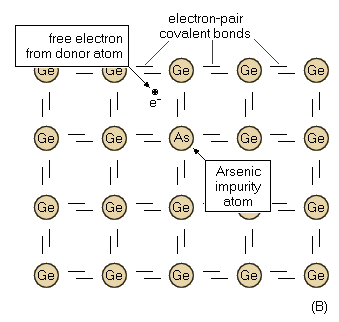| Transistor Basics is a free introductory textbook on transistors and their basic applications. See the editorial for more information.... |

|

Home  Basic Semiconductor Physics Basic Semiconductor Physics  Crystal Structure Crystal Structure  Donors - N-Type Germanium Donors - N-Type Germanium |
|






|
|
|
Donors - N-Type GermaniumAuthor: Leonard Krugman When impurities having five electrons in the valence ring are added to germanium, each impurity atom replaces a germanium atom. Four of the impurity atom's valence electrons form covalent bonds with the valence electrons of neighboring germanium atoms. The fifth electron is free and is available as a current carrier. Pentavalent-type impurities are called donors because they donate electrons to the crystal transistor germanium thus formed. Such transistor crystals are referred to as N-type because conduction is carried on by means of the Negatively charged electrons, contributed by the donor atoms. This action is illustrated by Fig. 1-3 (B), with arsenic acting as the pentavalent impurity.
Fig. 1-3. (B). N-type germanium. The application of a d-c potential across the N-type crystal forces the free electrons toward the positive voltage terminal. Every time an electron flows from the crystal to the positive terminal, an electron enters the crystal through the negative voltage terminal. In this manner a continuous stream of electrons flows through the crystal as long as the battery potential remains.
|
|
Home  Basic Semiconductor Physics Basic Semiconductor Physics  Crystal Structure Crystal Structure  Donors - N-Type Germanium Donors - N-Type Germanium |
|
Last Update: 2010-11-17


